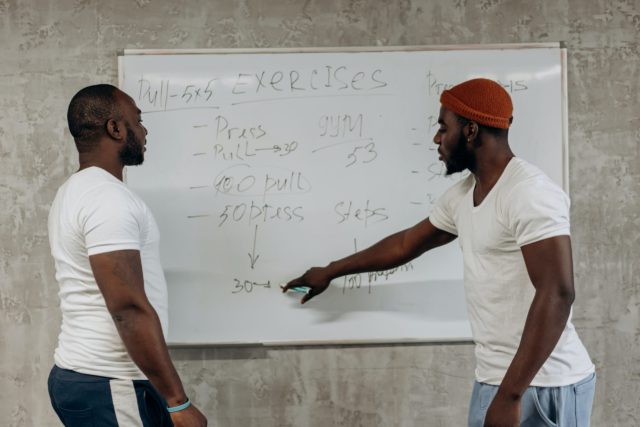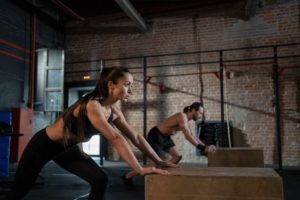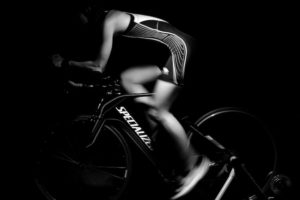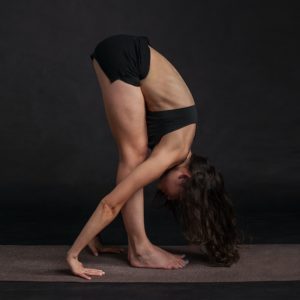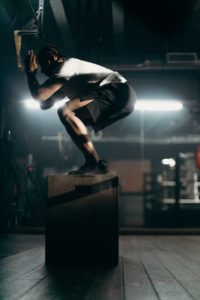Making the most out of your training time is beneficial in many ways. You’ll be able to get in and get out of the gym feeling like you actually worked out.
The best thing to do is to make sure that you have a workout plan! By having a workout plan you’ll be more efficient towards your goals. It won’t necessarily make the time at the gym faster, but it’ll eliminate that wonderingness of what exercise to do next.
Thinking about it, it might actually make your time at the gym a little quicker. It won’t be much quick but it’s something. If you’re a beginner and have zero clue on what to do at the gym, then this is the perfect read for you.
I created a 4 step approach on creating your very own workout plan that you can use to get the most out of your training time.
This post is not necessarily intended for beginners, if you’ve been working out for a while and want to change things up then this post will also benefit you.
The Benefit Of Having A Workout Plan
It’s easy to create a workout plan that’s designed specifically for your goal. Down below I’ve created a quick guide on how to make the most out of our training time. This quick guide will work for gym goers and to those who have equipment at home.
The 4 Steps On Creating Your Workout Plan
We’re going to be using the FITT VP model to create your very own workout plan. Here’s a quick summary of what FITT VP is. Basically, the FITT VP acronym stands for Frequency, Intensity, Time, Type, Volume, and Progression.
The American College of Sports Medicine (ACSM) created physical activity guidelines for healthy adults. If you want to read more about the FITT VP approach you can click this link.
Step 1: Choosing your workout split:
Choosing your workout split is very important when it comes to your training. This is the frequency and time part of the FITT VP model.
Frequency is calculated by the number of days per week for your workout.
Time is measured by the amount of physical activity time per session, day and week.
You want to make sure you are giving your body enough time for recovery. Also, you want to create a workout split that works with your schedule. I know that we’re all busy and sometimes it’s hard to find time for a workout.
Different Types Of Workout Splits:
5 day split: This is a workout split that has you working out every other day. This type of training allows for more recovery time and can be done if your schedule allows it.
- Push/Pull/Leg Split: This workout split allows you to work out 3 days per week. This is perfect for those who have very limited time.
- Pull Day: During Pull Day you want to focus on your back and biceps. Such as rowing, pull-ups, lat pulldowns.
- Push Day: This type of training session focuses more so the chest and triceps. Exercise movements such as bench press, shoulder press.
- Leg Day: Leg day session is all about legs! I like to add abdominal workouts during this day. Although, your abdominal muscles are those rare muscles that have a fast recovery rate.
Full Body Split: The name says it all. Full body split is when you’re performing full-body movement exercises. Examples of Full Body Exercise movements are power cleans, Snatch movements, Running, Jogging, and Walking.
There are many more workouts splits you can choose from. I created a post specifically about workout slits. check it out HERE.
Make sure you pick the right workout split that is more convenient for your schedule. Picking the wrong workout split can lead to overtraining. It’s important you’re following the recommended guidelines made by ACSM to ensure safety and adherence to your workouts.
Step 2: Choosing the right exercises
Depending on your workout split, you need to choose the right exercises. This is the “type” part of the FITT VP model. Type is the different type/modes of exercise.
For example, for leg day, you want to focus on leg exercises. For Pull Day, you want to focus on pulling exercises.
List For Back/Biceps/Pull Day Exercises:
- Bicep Curls: Curls can be performed with dumbbells, a barbel, EZ curl bar, resistance bands. Also, you can incorporate different types of Bicep Curl Variations.
- Pull Down: Lat Pull Down can be performed with machines, or resistance bands.
- Pull Ups: If you’re unable to perform full pull ups you can use bands to help assist your. Also, modified pulls can be performed.
- Seated Rows: Seated rows can also be done with machines or resistance bands.
- Bent Over Rows: Bent over rows can be done with machines, dumbbells, barbell, or resistance bands.
- Back Extensions: Back extensions can be done with just your own body weight.
List For Chest/Triceps/Push Day Exercises:
- Push Up: Lie down on your stomach and then raise yourself up to a 90 degree angle with elbows bent.
- Chair Push Up: If one does not have access to a bench, they can use chairs as well! If it’s too hard there should be an option where someone else holds their feet.
- Bench Press: Bench Press can be done with dumbbells, a barbell, or a resistance band.
- Dumbbell Fly: This is another one of my favorite chest exercises. You can do the dumb bell fly exercise using a bench or with resistance bands. Cable machines are also great for chest flies.
- Shoulder Press: This is one of my favorite shoulder exercises because it works the front, side and back muscles in your shoulders! You can do this exercise using a barbell, dumbbell or with resistance bands (which I prefer).
- Shoulder Front Raises: This is another one of my favorite shoulder exercises because it works the front, side and back muscles in your shoulders! You can do this exercise using a dumbbell, resistance bands, or a cable machine.
- Triceps Pushdown: This is one of my favorite tricep exercises because it works the long head, medial and lateral heads of your triceps! You can do this exercise using a barbell, cable machines, dumbbells or with resistance bands.
Take note: These exercises can be modified by simply changing your grip. Also, you can do single side exercises. For example, doing 8 reps of bicep curls with the right arm then switching to the left and doing 8 reps.
List For Legs and Core Day Exercises:
The benefits of leg and core exercises is that they will help you to maintain a healthy weight and help prevent injuries. The benefits for abdominal exercise are: it can reduce back pain, improve posture!
Leg Exercise:
- Squats: Squats are a great way to tone your legs and butt. They also help improve flexibility in the hips, knees or ankles!
- Lunges: Lunges can be performed weighted or bodyweight. Lunges can also be done stationary or with a walking motion. Lunges can also be performed with a twist motion.
- Calf Raises: Calf raises are great for toning the calf muscles and increasing ankle flexibility!
- Good Morning: Good morning exercise will target your hamstring and glute muscles.
- Deadlift: Deadlift is a great exercise for your hamstrings, glutes and lower back.
Core Exercises:
- Crunches: Crunches are a great way to tone your abdominal muscles. Crunch exercises can also be done with an exercise ball or on the floor!
- Sit Ups: Sit ups is one of those exercises that has been around for many years. Sit ups are a great way to tone your abdominal muscles.
- Planks: Planking is one of the best exercises for strengthening and toning core muscles. Planks will also help reduce back injuries by strengthening your core muscles.
List For Full Body Day Exercises:
One of the benefits of full body exercise is you burn more calories due to the fact that you are working out more muscles. This is because different muscle groups work together to provide movement and support for the body during exercise.
- Burpees: This exercise is a full-body workout because it works out your arms, legs and core. To do this move you will need to stand with your feet shoulder-width apart, squat down and put your hands on the ground. From there you will jump up into a pushup position before returning to the squat position and jumping up in one fluid motion.
- Mountain Climbers: This is a full-body exercise that works out your arms, legs and core. To do this move you will need to stand with one foot in front of the other and then bring your knee up to touch it.
- Running: Running is one of the best full body workouts to do. You’ll increase your heart rate for the duration of the run. Also, you’ll burn a lot of calories!
- Jogging: Is a great modification for running. If you’re like me and despise running then this is a great alternative.
- Box Jumps: Box jumps are one of the best full body workouts because they work out your arms, legs and core.
You can also combine different exercises together and create a superset to establish a full body workout. For example, performing the squats then right after the exercise doing crunches or some type of core workout. Supersetting is a great way of burning more calories.
Step 3: Choosing The Reps and Sets
Choosing the correct number of repetition and sets is very important. There have been many studies when it comes to the right repetition and sets.
For cardiovascular training (endurance): ACSM recommends an intensity of moderate and/or vigorous for most adults. Light to moderate intensity for individuals who are not well conditioned.
For Resistance Training (weight training): Moderate to vigorous intensity for novice and vigorous to very vigorous intensity for experienced strength trainers. Also, it’s recommended for older and sedentary individuals to go very light to light intensity.
Here’s a quick summary: the ACSM recommends a range of 8-12 reps to improve strength and power and 10-15 reps to improve strength in middle aged and older individuals.
For endurance, they recommend 30+ repetitions per set to improve cardiovascular health as well with the goal being 60 minutes or more in duration.
Make sure you pick the right number of reps and sets for your goal. This part gets confusing when it comes to the ACSM recommendation. Please, if you have any questions don’t hesitate to reach out to me. Here’s the link again to the FITT VP model approach.
Step 4: Preventing A Fitness Plateau
The last step is making sure you don’t hit a fitness plateau. A fitness plateau is when you stop improving. This is usually due to a lack of progression. Once our body adapts to the same workout plan/routine, that’s when we start to see little to no change. Which will cause discouragements and lack of motivation.
The key for preventing this from happening, and the best way you can make sure that your fitness level doesn’t stagnate or decrease over time (which will happen if there’s no change in intensity), is by changing up how often/how long workouts are done each week as well what exercises they are.
You can also change up the order of exercises, or even switch to a different type (eccentric-concentric) for some workouts and see what happens! If you’re feeling really ambitious then try adding in an additional workout day each week with one set per exercise done at high intensity until failure on that particular muscle group.
This is also a good way for you not getting bored with your workouts and keep them interesting!
The way I change my workouts is by changing the exercises I do, or by changing my sets and reps. For example: If I’m doing 20 push-ups a day for a week, I’ll try and do 25 push-ups a day for the next few weeks.
Or if you are currently lifting weights and want to change it up: Try adding in some cardio or yoga into your routine! It’s all about progressing! Small changes yield great results!
FAQ
What is the best way to make sure I'm getting a good workout?
The key thing about working out and making it effective, in my opinion at least is consistency! Try your hardest not to miss workouts or days of exercise because you will lose all that hard work if this happens too often (trust me). If you are unable to make it in the gym, try doing some exercises at home or on your own.
How do I know if my workout is effective?
The best way you can tell that a workout was good and had an impact -is by how sore (or not) of muscles feel afterwards! If they’re feeling really tight then high intensity workouts have been done recently; whereas when there’s no pain whatsoever after exercise this usually means low intensities have taken place which isn’t as beneficial for muscle growth/toning.
What should be included into one’s diet while working towards their fitness goals ?
It all depends what kind goal someone wants but for someone who’s looking to lose weight, it’s ideal for that person to have a lower intake of calories than their expenditure. For example, if someone burns 2500 calories a day and eats 2000 then they’ll be in the negative calorie balance which is what’s needed to lose weight.
What are some of the most common mistakes people make when working out?
The biggest mistake is not having a plan or goal in mind before starting to exercise, which can lead you down many paths that may end up being ineffective for your goals! It’s important as well with any type workout routine (whether it’s weight lifting/cardio) to have an idea on how long each session should last so there isn’t too much time wasted doing something inefficiently; this will also help prevent injury because one knows their limits better than they would without planning ahead.

